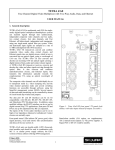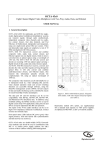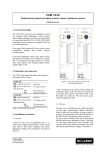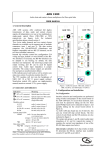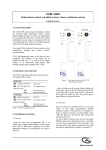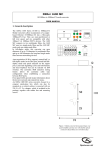Download English - Siqura
Transcript
TETRA 42x0 Four Channel Digital Video Multiplexer with Two-Way Data USER MANUAL 1. General description TETRA 42x0 (4210 for multimode, and 4250 for singlemode) digital-optical multiplexer/demultiplexer systems can transmit signals through four unidirectional, independent composite video channels and one bidirectional data channel using one optical fiber per system. Video and data/audio input signals are sampled and digitised with 10-bit accuracy. TETRA 42x0 TX unit receives input via the four BNC connectors. It then converts and combines the four channels of composite video with the data channel into one digital data stream. This, in turn, is converted into an optical signal, with a wavelength of 1310 nm. The TETRA 42x0 TX also converts and decodes an incoming 1550 nm digital optical signal from the mating RX unit that includes the data in the opposite (return) direction. The TETRA 42x0 RX receives, converts and decodes the video and data signals arriving through the optical fiber via a 1310 nm optical carrier. It also converts and serializes the incoming data signal and transmits this information optically in the opposite direction towards the complementary TX, using an optical wavelength of 1550 nm. The composite video channels are digitally clamped after being AC coupled at the inputs. The digital clamp is compatible with NTSC and PAL sync timing. The video channels are not compatible with non-video (NTSC and PAL) signals. The data channel I/O compatibility (RS-232, RS-422, RS-485-4W, and RS-485-2W) and termination configuration is selectable via an on board 10 position dip-switch. See Data Configuration. Front panel status LEDs indicate DC power OK, video signal presence, local and remote link synchronisation. TETRA 42x0 units are single-width (7TE) Eurocardsized modules and should be used in combination with MC 11 or similar power supply cabinets. Stand-alone models (/SA option, see supplementary /SA-2 manual) need separate 12 Vdc power supplies. A Siqura PSA 12 DC-25 would be suitable. © Siqura 2015 Version 090902-1d) TETRA42x0TX&RX (MW10) Figure 1. Tetra 42x0 RX Front Panel. TX panels look similar, with video inputs instead of outputs. See Table 1. 2. Indications and connectors Table 1 lists the front panel features of TETRA 42x0 modules (refer to figure 1). Connector pin assignments are detailed in section 4. TETRA 42x0 TX o (SC/UPC connector) o (BNC connector) 1-8 TETRA 42x0 RX o (SC/UPC connector) o (BNC connector) 1-8 Optical video/data out, optical data in Composite video in Optical video/data in, optical data out Composite video out TETRA 42x0 TX and RX (2x) Front panel screws Status indicator LEDs SYNC DC NV (red) No sync from optical in or no internal sync (orange) No sync from remote optical in (green) All sync OK (green) DC power OK (red) TX: no video in RX: no video out Figure 2: Location of Data Type Select, Line Bias, and Termination Dipswitch Table 1. TETRA 42x0 front panel features 3. Configuration To access the internal Data Type Select, Line Bias, and Termination Dipswitch, remove the two screws on the front panel as indicated in figure 3, and slide out the circuit card assembly. Figure 3. Access to internal configuration dipswitch 2 (-V / GND). This bias ensures that the input line receiver interprets the state of the differential bus as a logical “zero” while all the drivers attached to the differential bus are in a Hi-Z state. There must be at least one device on the differential bus with the Line Receiver Input Bias (BR) enabled (Switch #s 7 and 8 ON). Typically, BR is enabled along with the termination at one end (only) of the bus. However, if other devices occupy the end positions on the bus, and are terminated, it needs to be ensured that there is adequate bias on the bus for proper operation. Sometimes other devices provide bias. If not, enable BR on one of the TETRA 42x0 units on the bus. To determine if adequate bias is present, while there is no data activity on the bus (disable the master unit if required) attach the (+) lead of a VOM to the (+) lead of the bus and connect the (-) lead to the (-) lead of the bus and take a voltage measurement. For optimum operation, the reading should be at least +200 mV. If it is less, and there are operation problems, enable BR by setting switches 7 and 8 in the ON position on one TETRA 42x0 connected to the bus. Data Type Select, Line Bias, and Termination Dipswitch Settings: Data Interface Compatibility Selection: Set switch positions 1 through 5 of the Data Type Select, Line Bias, and Termination Dipswitch to determine whether the data port operates in RS-232, RS-422, RS-485 4W, or RS-485 2W compatibility mode. Refer to Table 2. 1 2 3 4 5 RS-232 OFF OFF ON OFF OFF RS-422 ON OFF OFF ON ON RS-485 4W OFF ON OFF ON ON RS-485 2W ON ON OFF ON ON Table 2. Selecting the Data Port Interface Compatibility Note: The Factory Default Setting is RS-485 4W Up is OFF, and Down is ON. RS-422, RS-4852W, and RS-485 4W Manchester Line Bias and, Termination: In addition to selecting the data interface compatibility above, set positions 6 through 10 to satisfy the proper line bias and termination conditions to insure proper operation. Refer to table 3. 6 7 8 9 10 RS232 OFF OFF OFF OFF OFF RS422 ON BR BR OFF OFF RS485-4W T BR BR BD BD RS485-2W T BR BR OFF OFF RS-485 4W Line Driver Output Bias (BD): Switch positions 9 and 10, when ON, connect 390 ohm bias resistors on the (+) and (-) outputs. The (+) output is biased towards (+V) and the (-) output is biased towards (-V / GND). This bias ensures that the input line receivers in other RS-485 4W devices connected to the bus interpret voltage level on the bus as a logical “zero” while the TETRA 42x0 RS-485 4W output is in the Hi-Z state. Sometimes other devices provide this bias. If not, enable BD on one of the TETRA 42x0 units on the bus by setting switches 9 and 10 in the ON position. To determine if adequate bias is present, while there is no data activity on the bus (disable the master unit if required), attach the (+) lead of a VOM to the “A” lead of the bus and connect the (-) lead to the “B” lead of the bus and take a voltage measurement. For optimum operation, the reading should be at least +200 mV. If it is less, and there are operation problems, enable BD by setting switches 9 and 10 in the ON position on one TETRA 42x0 connected to the bus. Table 3. Data I/O Configuration, Termination, and Biasing for the Data Port. See text for the definition of “T”, “BR”, and “BD”. Note: The Factory Default Setting is All switches ON (RS485 4W, Terminated and Biased) Up in Off ,and Down is On RS-485 Termination (T): When switch position #6 is OFF , the RS-485 input is unterminated. When it is the ON position, the differential input is terminated with 120 ohms resistance. For RS-485 installations, there might be a number of RS-485 devices anywhere from 2 to 32 attached to the differential bus. Normally, the devices at the two extremes of the bus are terminated (switch #6 ON), while intermediate devices are not (switch #6 OFF). RS-485 2W and 4W Line Receiver Input Bias (BR): Switch positions 7 and 8, when ON, connect 390 ohm bias resistors on the (+) and (-) inputs. The (+) input is biased towards (+V) and the(-) input is biased towards 3 4. Data Port Connector Pin Assignments 6. Technical specifications In the following Optical Specifications section: a) 4210 refers to an TETRA 4210 TX and TETRA 4210 RX pair for multimode operation b) 4250 refers to an TETRA 4250 TX and TETRA 4250 RX pair for single-mode operation Optical 4210 4250 TX Output Wavelength 1310 1310 RX Output Wavelength 1550 1550 No. of fibers, fiber type 1, MM 1, SM TX Output Power >-4 >-4 RX Min.Input Power -22 -28 TX to RX Link Budget 18 24 Rx Output Power -7 -7 TX Min. input power -22 -25 RX to TX Link Budget 23 27 Link Length, Max 4* 52 *Range may be limited by fiber bandwidth. . Terminal ID INPUT + INPUT – OUTPUT + OUTPUT - RS232 IN NC OUT NC RS422 IN (+) IN (-) OUT (+) OUT (-) RS485-4W IN (+) IN (-) OUT (+) OUT (-) RS485-2W IN (+) IN (-) OUT (+) OUT (-) GROUND COM GROUND GROUND GROUND UnitTETRA 42x0 nm Nm dBm dBm dB dBm dBm dB km Table 5. TETRA 42x0 TX/RX Optical Specifications The technical specifications of the TETRA 42x0 system are listed in table 6 below. TETRA 42x0 4210 4210 Video Table 4. Pin assignments for the Data I/O port (five position pluggable screw terminal ) No. of channels Video format Input/Output level DC restore(clamping) Bandwidth (-3 dB) Sampling res @ freq. Differential gain Differential phase Group delay SNR 5. Installation 1. Plug the modules into the appropriate power supply cabinet (or hook up the /SA-2 models to corresponding power supplies) and connect suitable video and optical fiber equipment using appropriate cabling. CLEAN THE OPTICAL FIBER CONNECTORS PRIOR TO INSERTION INTO THE OPTICAL PORT. For long electrical data links, twisted pair wiring should be used. Through-connecting the signal ground lines is recommended; equipment and cabling should be installed and earthed such that protection is provided against lightning and similar influences. 4 PAL/NTSC 1, nominal Yes 6 10 bit @56 MHz <2 <1 <20 >63 (wtd.) Vpp MHz % ° ns dB Data Number of channels Data format Data interfaces Data rate Sampling Rate 1, full duplex Asynchronous, serial RS-232, RS-422, RS485 (2W or 4W) DC to 256 kbit/s (RS-422/RS-485) DC to 115,2 kbit/s (RS-232) 3 MSamples/s Environmental and Safety Operating temp. -40 to +74 C Relative humidity < 95 % (no condensation) MTBF >100,000 hrs Electrical safety AL / IEC / EN 60950-1 UL recognition file E242498 Laser safety IEC 60825-1, IEC 60825-2 EMC immunity EN 55024, EN 50130-4, EN 61000-6-2 EMC emission EN 55022 (Class B) FCC 47 CFR 15 (Class B) 2. Upon powering up, the green DC LEDs and SYNC LEDs should glow green, indicating link integrity. If a SYNC LED shines red on either unit, there is no incoming link synchronisation at that unit. If SYNC problems occur after powering up, first check the received optical power arriving at the unit with the red SYNC LED using an optical power meter. Electrical Supply voltages Power consumption Current 3. With the optical link in good order, connecting a video signal should make the corresponding channel's TX and RX NV (no video) LEDs go out. An RX NV LED still lit would indicate that no decodeable video signal is arriving through the associated channel. 12-15 (/SA) <2.6 200 @ 12 V Vdc W mA Mechanical Optical connector Video connector Data connectors Dimensions Weight (approx.) ST/PC SC/UPC BNC 75 5-pin screw terminal HxWxD =128 x 35 x 190 480 mm g Table 6. TETRA 42x0 TX/RX Technical Specifications 4 Optical safety 7. Care and maintenance This optical equipment contains Class 1M lasers or LEDs and has been designed and tested to meet IEC 60825-1:1993+A1+A2 and IEC 60825-2:2004 safety class 1M requirements. Optical equipment presents potential hazards to testing and servicing personnel owing to high levels of optical radiation. When using magnifying optical instruments, avoid looking directly into the output of an operating transmitter or into the end of a fiber connected to an operating transmitter, or there will be a risk of permanent eye damage. Precautions should be taken to prevent exposure to optical radiation when the unit is removed from its enclosure or when the fiber is disconnected from the unit. The optical radiation is invisible to the eye. Use of controls or adjustments or procedures other than those specified herein may result in hazardous radiation exposure. The installer is responsible for ensuring that the label depicted below (background: yellow; border and text: black) is present in the restricted locations where this equipment is installed. For reliable operation of TETRA 42x0 modules, observe the following precautions: - Prevent dust from collecting on the equipment - Protect the equipment against moisture - Maintain sufficient free space around the equipment for cooling. 8. Safety, EMC, ESD General The safety information contained in this section, and on other pages of this manual, must be observed whenever this unit is operated, serviced, or repaired. Failure to comply with any precaution, warning, or instruction noted in the manual is in violation of the standards of design, manufacture, and intended use of the unit. Installation, adjustment, maintenance and repair of this equipment are to be performed by trained personnel aware of the hazards involved. For correct and safe use of the equipment and in order to keep the equipment in a safe condition, it is essential that both operating and servicing personnel follow standard safety procedures in addition to the safety precautions and warnings specified in this manual, and that this unit be installed in locations accessible to trained service personnel only. Siqura assumes no liability for the customer’s failure to comply with any of these safety requirements. Hazard Level 1M The locations of all optical connections are listed in the Indications and Connectors section of this manual. Optical outputs and wavelengths are listed in the Technical Specifications section of this manual. UL/IEC/EN 60950-1: General safety requirements The equipment described in this manual has been designed and tested according to the UL/IEC/EN 60950-1 safety requirements. If there is any doubt regarding the safety of the equipment, do not put it into operation. This might be the case when the equipment shows physical damage or is stressed beyond tolerable limits (e.g. during storage and transportation). Before opening the equipment, disconnect it from all power sources. The equipment must be powered by a SELV*) power supply. When this unit is operated in extremely elevated temperature conditions, it is possible for internal and external metal surfaces to become extremely hot. 5 EMC 9. Product Disposal The equipment has been tested and found to meet the CEregulations relating to EMC, and complies with the limits for a Class B device, pursuant to Part 15 of the FCC rules. These limits are designed to provide reasonable protection against interference to radio communications in any installation. The equipment generates, uses and can radiate radio frequency energy; improper use or special circumstances may cause interference to other equipment or a performance decrease due to interference radiated by other equipment. In such cases, the user will have to take appropriate measures to reduce such interactions between this and other equipment. Any interruption of the shielding inside or outside the equipment could cause the equipment to be more prone to fail EMC requirements. Non-video signal lines must use appropriate shielded CAT5 cabling (S-FTP), or at least an equivalent. If system components, such as cabling (e.g. coaxial cable, data/audio/cc wiring) and/or the units, are used outdoors, ensure that all electrically connected components are carefully earthed and protected against surges (high voltage transients caused by switching or lightning). The unit contains valuable materials which qualify for recycling. In the interest of protecting the natural environment, properly recycling the unit at the end of its service life is imperative. ESD Electrostatic discharge (ESD) can damage or destroy electronic components. Proper precautions should be taken against ESD when opening the equipment. *) SELV: conforming to IEC 60950-1, <60 Vdc output, output voltage galvanically isolated from mains. All power supplies or power supply cabinets available from Siqura comply with these SELV requirements. 6






